Card Index
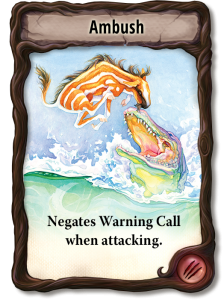 AMBUSH
AMBUSH
Allows a Carnivore to attack a species protected by the Warning Call trait.
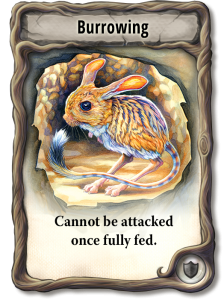 BURROWING
BURROWING
This species may not be attacked by a Carnivore if it has food equal to its Population. A Carnivore with Intelligence may discard a card to negate Burrowing.
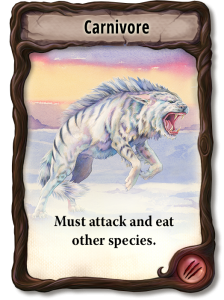 CARNIVORE
CARNIVORE
This species may attack another species during Feeding if its Body Size is greater than the Body Size of the species being attacked, and it has the traits necessary to overcome that species’ defensive traits. Carnivores may never take Plant Food, even with other traits such as Long Neck, Cooperation, or Foraging. Carnivores must attack even if the only available prey is the player’s own species.
 CLIMBING
CLIMBING
A species with Climbing may not be attacked unless the attacking Carnivore also has the Climbing trait. A Carnivore with Intelligence may discard a card to negate Climbing.
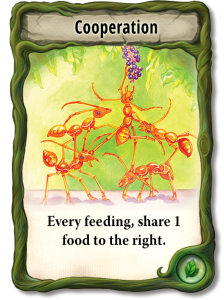 COOPERATION
COOPERATION
Anytime this species takes food, if you have a species to the right of it, that species takes 1 food of the same type (Plant or Meat) from the same source (Watering Hole or Food Bank). This means Cooperation will get triggered by traits such as Long Neck, Scavenger, Intelligence, and even another Cooperation (but not Fat Tissue).
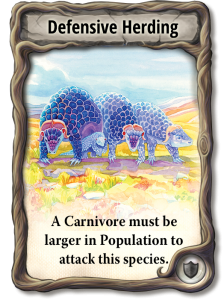 DEFENSIVE HERDING
DEFENSIVE HERDING
A species with Defensive Herding may not be attacked unless the attacking Carnivore has a greater Population. A Carnivore with Intelligence may discard a card to negate Defensive Herding.
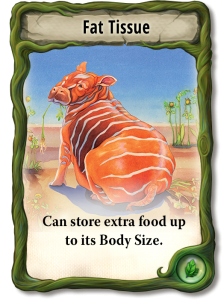 FAT TISSUE
FAT TISSUE
This species may continue to place food on the Fat Tissue trait icon once it has taken food equal to its population. The food stored on Fat Tissue may not be greater than the Body Size of this species. The food stored on Fat Tissue is neither Plant Food nor Meat Food – it is fat. Before the Food Cards are revealed, food tokens on the Fat Tissue Icon are moved onto the the Species’ Population slots without exceeding its Population. This does not trigger Cooperation or any other trait that triggers when a species “takes” food. Any food remaining on this icon is scored to the Food Bag when the trait is replaced, removed from extinction, or at the end of the game.
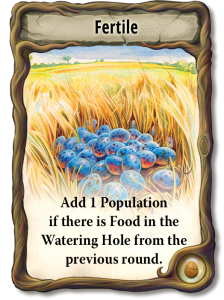 FERTILE
FERTILE
Before the Food Cards are revealed, this species gains 1 Population if there is food in the Watering Hole.
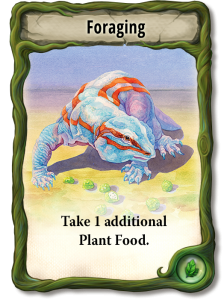 FORAGING
FORAGING
This species takes 1 additional Plant Food from the same source (Watering Hole or Food Bank) anytime it takes Plant Food (unless it does not have enough Population to take additional Plant Food). Foraging can be triggered by other traits such as Cooperation, Long Neck or Intelligence.
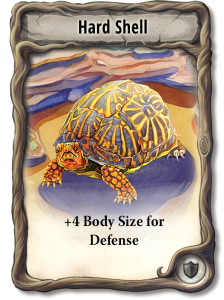 HARD SHELL
HARD SHELL
Add 4 to this species’ Body Size when determining if a Carnivore can attack it. A species with Body Size 6 and Hard Shell will have an effective Body Size of 10. Hard Shell does not increase the amount of Meat Food that a Carnivore takes after an attack.
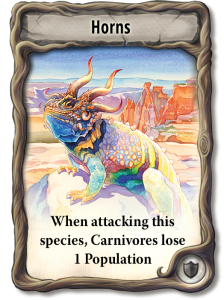 HORNS
HORNS
A carnivore must reduce its Population by 1 when attacking this species. The reduction in Population occurs before the Carnivore takes Meat Food for the attack.
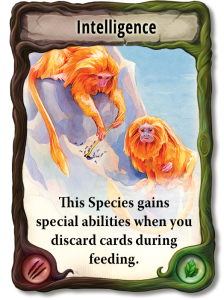 INTELLIGENCE
INTELLIGENCE
A player with Intelligence has the option to discard one or more cards from their hand during any of their Feeding turns to gain one of the following effects:
– If the species with Intelligence is a Non-carnivore, it takes 2 Plant Food from the Food Bank for each card discarded. This may be done before or after the player’s normal feeding turn.
– If the species with Intelligence is a Carnivore, each card discarded negates one defensive trait on a target prey.
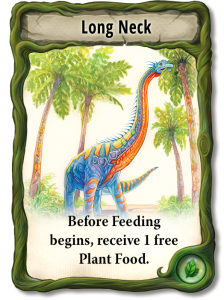 LONG NECK
LONG NECK
Take 1 Plant Food from the Food Bank (not the Watering Hole) when the Food Cards are revealed.
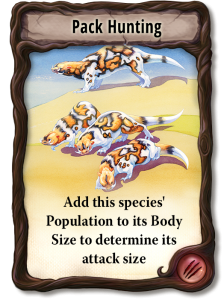 PACK HUNTING
PACK HUNTING
This species’ Body Size is equal to its Population plus its Body Size when determining if it can attack another species. A species with a Population of 5 and a Body Size of 3 will have an effective Body Size of 8 when determining if it can attack another species.
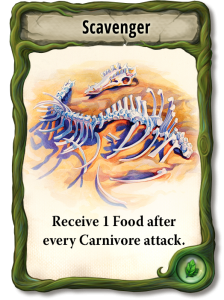 SCAVENGER
SCAVENGER
Take 1 food from the Food Bank anytime a species loses one or more population after being attacked by a Carnivore. The Scavenger trait works as normal if it is on the attacking Carnivore (the Carnivore gets an extra food) or on the species that was attacked (the attacked species gets 1 food but only after losing 1 Population).
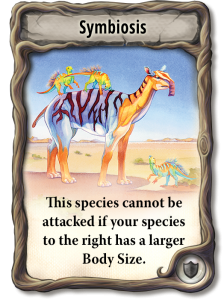 SYMBIOSIS
SYMBIOSIS
If you have a species to this species’ right with a larger Body Size, this species cannot be attacked. A Carnivore with Intelligence may discard a card to negate this defensive trait.
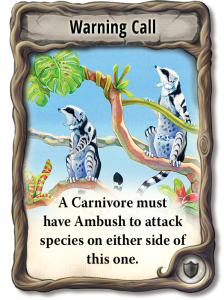 WARNING CALL
WARNING CALL
A Carnivore must have Ambush to attack species on either side of this one.
Climate Cards
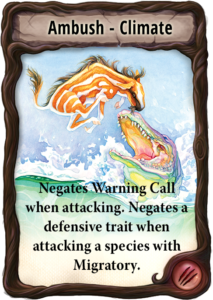 AMBUSH
AMBUSH
Allows a Carnivore to attack a species protected by the Warning Call trait. Negates a defensive trait when attacking a species with Migratory.
Ambush picks up an additional ability in Climate that lets it negate one defensive trait on a species that also has the Migratory trait.
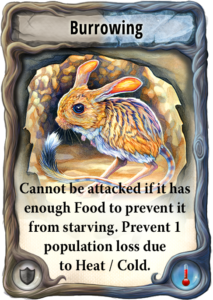 BURROWING
BURROWING
A Carnivore cannot attack this species unless one or more of its Population is hungry. Normally this protection is only active when the Burrowing species is fully fed, but a species with Burrowing and Hibernation is protected when all but 2 of their Population is fed.
Population loss due to both heat and cold is reduced by 1 for this species. For example, in the Ice Age Climate zone, there are 4 X Kill icons representing 4 Population lost due to cold. A species with Burrowing negates 1 of those Kill Icons, so it loses only 3 Population.
Burrowing enables species to hide from predators, making them vulnerable only when they leave their lair to find food. Burrowing also provides protection from extreme temperatures. A burrowing species can escape direct sunlight by retreating into the cooler ground. Likewise, a burrower can escape the cold winter nights by retreating to a well-insulated lair.
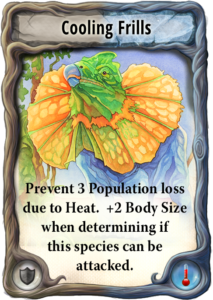 COOLING FRILLS
COOLING FRILLS
Add 2 to this species’ Body Size when determining if a Carnivore can attack it. A species with Body Size 6 and Cooling Frills will have an effective Body Size of 8. Cooling Frills does not increase the amount of Meat Food that a Carnivore takes after an attack
Population loss due to heat is reduced by 3 for this species. For example, in the Scorching Climate zone, there are 4 X Kill icons representing 4 Population lost due to heat. A species with Cooling Frills negates 3 of those icons, so it loses only 1 Population.
The most efficient way for an animal to dissipate heat is to have a high ratio of body surface area compared to its weight. A large frill, such as those on the Frilled-Neck Lizard, allows an animal to cool itself by unfurling its frills. This gives the species a temporary increase in their body’s surface area from which to dissipate heat. An additional benefit is that the frills can be expanded to deceive predators into thinking the animal is larger than it is.
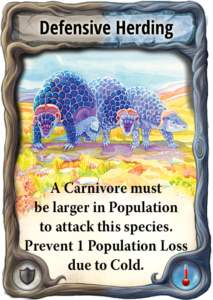 DEFENSIVE HERDING
DEFENSIVE HERDING
A species with Defensive Herding may not be attacked unless the attacking Carnivore has a Population that is greater than the Population of the species with Defensive Herding.
Population loss due to cold is reduced by 1 for this species. For example, in the Ice Age Climate zone, there are 4 X Kill icons representing 4 Population lost due to cold. A species with Defensive Herding negates 1 of those Icons, so it loses only 3 Population.
Herding is not only used as a defensive mechanism, but also as a way of sharing body heat to stay warm in the cold. Emperor Penguin colonies huddle together to conserve body heat and shield themselves from the frigid winds of Antarctica. Each penguin takes a turn on the outside of the huddle before shifting back to the inside to get warm again.
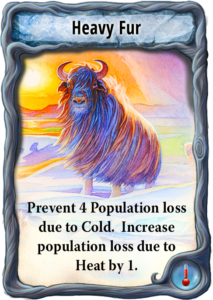 HEAVY FUR
HEAVY FUR
Population loss due to cold is reduced by 4 on this species. For example, in the Ice Age Climate zone, there are 4 X Kill Icons representing 4 Population lost due to cold. A species with Heavy Fur negates all 4 of those Icons and loses no Population instead.
Population loss due to heat in the three hottest Climate zones is increased by 1 for this species. For example, in the Scorching Climate zone, there are 4 X Kill icons representing 4 Population lost due to heat. A species with Heavy Fur loses 5 Population instead.
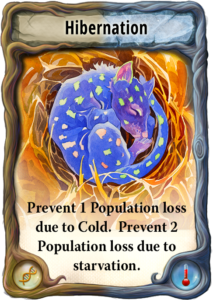 HIBERNATION
HIBERNATION
Up to 2 Population may be ignored when determining if this species is hungry. Those Population don’t need to be fed during Phase 5: Feeding and they won’t be lost due to hunger at the End of Feeding. A species with Burrowing and Hibernation is protected when all but 2 of their Population is fed.
Population loss due to cold is reduced by 1 for this species. For example, in the Ice Age Climate zone, there are 4 X Kill icons representing 4 Population lost due to cold. A species with Hibernation negates 1 of those Icons, so it loses only 3 Population.
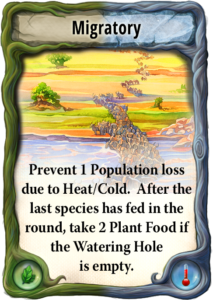 MIGRATORY
MIGRATORY
After all species have finished feeding for the round, this species takes up to 2 Food from the Food Bank if the Watering Hole is empty (provided it has enough hungry Population). This occurs even if there was no Watering Hole Food during the round.
Population loss due to both heat and cold is reduced by 1 for this species. For example, in the Ice Age Climate zone, there are 4 X Kill icons representing 4 Population lost due to cold. A species with Migratory negates 1 of those icons, so it loses only 3 Population.
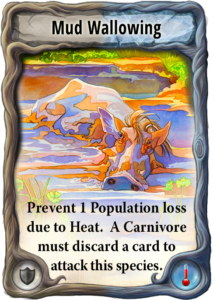 MUD WALLOWING
MUD WALLOWING
A player must discard a card from their hand to the faceup Discard Pile before their Carnivore may attack a species with the Mud Wallowing trait. A card must be discarded before each attack.
Population loss due to heat is reduced by 1 for this species. For example, in the Scorching Climate zone, there are 4 X icons representing 4 Population lost due to heat. A species with Mud Wallowing negates 1 of those X icons, so it loses only 3 Population.
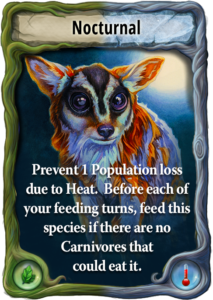 NOCTURNAL
NOCTURNAL
Before each of your feeding turns, this species (Carnivore or Non-Carnivore) may take a free feeding action if there are no Carnivores in play that could eat it. You may feed the same species again during your normal feeding action or you may feed a different species. The additional feeding triggers cards such as Cooperation and Foraging.
To determine if Nocturnal is in effect, a Carnivore with Intelligence is considered able to eat the Nocturnal species only if the Carnivore’s owner has enough cards in hand to get past all of the Nocturnal species’ defensive traits. Carnivores that are fully fed are unable to attack any species.
Population loss due to heat is reduced by 1 for this species. For example, in the Scorching Climate zone, there are 4 X icons representing 4 Population lost due to heat. A species with Nocturnal negates 1 of those X icons, so it loses only 3 Population.
